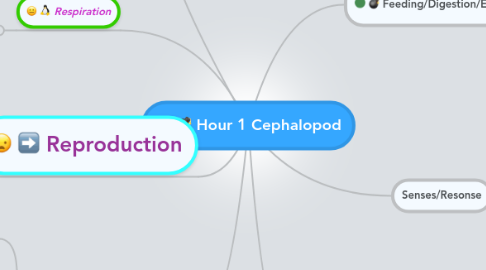Hour 1 Cephalopod
Karla Lockmanにより

1. Respiration
1.1. Cuttlefish respiration uses copper instead of iron
1.2. Cephalopods breathe by using their gills. Modern cephalopods have two gills.
2. Anatomy
2.1. Octopus (external): 8 legs with tentacles & one large eye
2.2. Octopus (internal): beak, crop, gizzard, poison gland, ink sac, brain, funnel & skull
2.3. Cuttlefish (internal): heart, stomach, ink sac, gill, gonad, anus, brain, salivary gland, and kidney.
2.4. Cuttlefish (external): arms, tentacle, & long skinny body.
3. Reproduction
3.1. For reproduction the male produces a special arm called a hectocotylus. With that he transfers a sperm packet to the female's pallial cavity. The female later lays a number of eggs, out of which the small larvae hatch. ;)
4. Circulation
4.1. Most of the cephalopods have a closed circulatory system. They also have more than one heart. Some cephlapods live much longer than other cephlapods due to different things within the circulatory system of the body.
5. Feeding/Digestion/Excretion
5.1. cuttlefish feed using their tentacles to catch and bring prey to their month
5.2. if an Octopus feeds on a hard shelled organism it uses its tongue to bore into the shell
5.3. Squids have small beak like mouths that are used to rip apart prey to make it easier for digestion or break open shells
6. Senses/Resonse
6.1. Cephalopods have sophisticated eyes. They can see light and darkness and both forward and backward. They can taste through their tentacles.
7. Movement
7.1. Most of the cephalopods can move by shooting water out of their body like a jet. Most can also flap their arms or fins alongside their body


